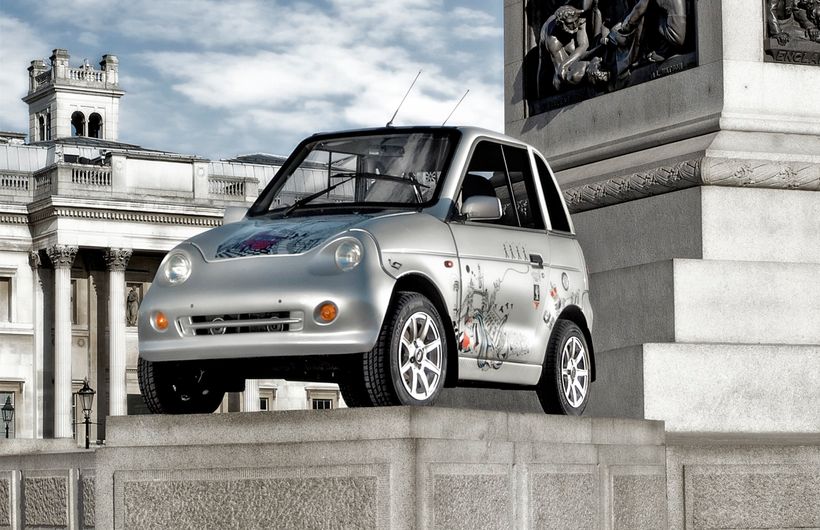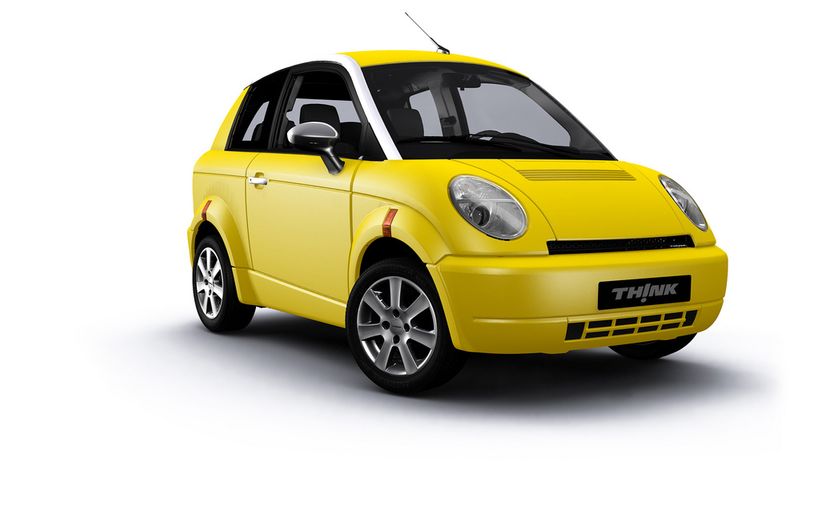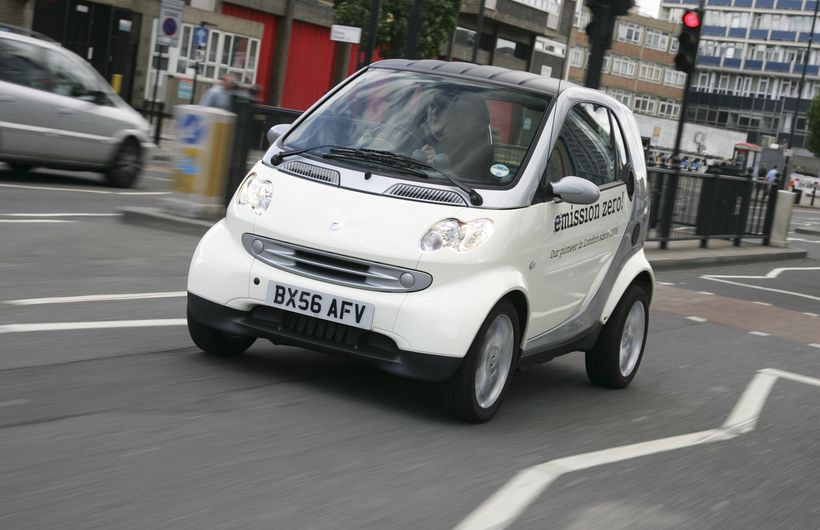Want to know a secret? Electric cars haven’t always been slinky visions of the future that feature all the must-have tech and environmental credentials they have right now. There have been misfires, if you’ll forgive the rubbish pun. In fact, just like internal combustion, there have been a fair few 'voltswagens' that … didn’t quite lead the charge so much as remained… uh… static. Welcome then, to a list of electric cars that blew a fuse well before EVs became popular.
*NB/ May contain terrible jokes about electricity.
Reva G-Wiz
Electric cars have actually been around since the 1830s when people from south of Watford were still scared of ‘outsiders’ from Burnley who talked with strong accents. Indeed, in the late 1800s - a time when social standing tended to be determined by the size of your hat - most taxis in London were Walter Bersey’s electric cabs. But even those early pioneers would likely have recoiled at the Reva G-Wiz, and not just because of the silly name.
The G-Wiz is a car in the same way that a cat is a horse. Same basic architecture, wildly different outcome. Produced between 2001 and 2012, the G-Wiz was actually originally classed as a quadricycle - a four-wheeled motorcycle - that used eight, six-volt lead-acid batteries under the front seats to produce around 15bhp. Enough to propel the G-wiz to a terrifying 50mph with a range of putatively 50 miles, although doing crazy things like using the headlights decreased range significantly. Yes, it was designed for urban commuting, but given that it would fold up like a wet paper towel in the event of a crash, you’d probably be better being hit by a car nude than wrapped in this particular conveyance. No. Just no.
Mahindra E2o
It’s not like we’re trying to have a go here, but the second car in the list is related to the G-Wiz. In fact, it’s the successor, the Mahindra E2o. Another microcar, it looks more solid than the Wiz, although still like a car that got half-squashed by a car-compactor. Starting at £13k for the base model back in 2016, and £16k for the ‘TechX’, the E2o was a commercial failure. With a 13.9kWh battery, 41bhp and 67lb ft of torque, it could apparently run rampant from zero to 50mph in 18 seconds, and was designed as an urban commuter car. I think I’d rather have a bicycle.
Th!nk City
You’ll forgive the marketing potential of replacing the ‘i’ in ‘think’ with an exclamation mark when you realise just what the purveyors of the Th!nk City were up against back in 2008. Originally a subset of Ford’s Th!nk Mobility offshoot, the City was a 24kWh EV that could manage 34bhp and 66lb ft of torque, with a pie-in-the-sky, winged-pig range of just under 100miles. It also looked like something a Teletubby would refuse to drive because it looked too daft. More than that, this was essentially a beta-test experimental car that retailed for TWENTY FIVE THOUSAND POUNDS in the UK, for which you could purchase a very nice ICE-engined saloon. The reason for the vitriol aimed at the car? It involves a very personal incident where a Th!nk with a full charge was driven to Heathrow and left with supposedly 65miles range. Upon return two days later, the battery had ‘leaked’ 50 miles of range and left yours truly unable to get home. Think about that.
Sinclair C5
Visionary is a word. A word applied to Sir Clive Sinclair, the man responsible for ZX-series of home computers (including the ZX-Spectrum and by default, the epic-yet-rubbish game JetPack) and the world’s first slimline pocket calculator. He was also responsible for the 1985 C5, a ‘car’ that appeared to be more of a child’s toy than serious transport solution, but nevertheless was touted as a BEV (battery electric vehicle) for the masses. Albeit one at a time. Technically it’s a ‘pedal-assisted electric tricycle’ and had a body and chassis designed by none other than Lotus. Issues included: lack of range - it would only do ‘up to’ 20 miles with its single car-type 12v lead-acid battery - safety concerns (it’s a recumbent, so hard to see on the road), general slowness (15 heady mph top end), surprising physical size and lack of weatherproofing (while lying down). Weirdly, it’s probably the right idea, at precisely the wrong time, and has become something of a cult buy for collectors of ’80s memorabilia. There’s even one modified version that’s been clocked at 150mph. Rather them than us…
![]()
Smart ForTwo Electric Drive (first iteration)
Now, Smart - a sub-brand of Daimler - makes some very nice small EVs, and the next-generation cars will actually be an all-electric range. BUT, back in 2007, the first generation of ForTwo was a little less successful. Powered by a 13.2kWh sodium-nickel chloride battery and modified by Zytek, the first-gen ForTwo ED managed just under 40bhp, had a supposed range of 68 miles and a top speed of 75mph. Except it really didn’t. On test for a popular motoring magazine, the little Smart managed less than 30 miles of range, at which point the charge degradation led to the car gradually losing performance. Unfortunately, the performance loss occurred on a dual carriageway some 10 miles from the nearest safe place to re-charge, thus leading to a nerve-wracking 27-minute game of dodge-the-articulated-lorry-that-can’t-see-you somewhere near Milton Keynes. It remains to this day the only car said reviewer awarded zero points. The reviewer was me. I still wake up in a cold sweat about it.
The Milk Float
There’s a lot to like about a milk float. It makes all kinds of sense when you think about it, and was absolutely ahead of its time. Silent, for early-morning or late-night urban deliveries. Smooth, for the movement of lots of glass bottles. No localised pollution, a very specific duty cycle (handy for something that needs to be charged regularly) and generally very fit-for-purpose, with a walk-through cabin, 16mph top speed and ability to haul. But the one thing a milk float did not do, was drive very well. Yes, it had a low centre of gravity, but that was more a happy accident than by design. The series-wired sets of lead-acid batteries were slung under the vehicle between the wheels - this is the time that if someone mentioned Lithium-Ion, the assumption would be that it was something to do with maintaining a sharp crease in a pair of comfortable slacks - but milk floats have all the dynamic ability of a housebrick.
Obviously, this isn’t something we’re condemning the humble milk float for - just pointing out that in terms of driving, this is probably one of the worst EVs ever to have graced the UK. And grace it they did - at one point in 1967 the UK Electric Vehicle Association - yes, that was a thing - put out a press release that stated the UK had more registered BEVs than the rest of the world put together. And it did - most of them were milk floats.
Corbin Sparrow
Looking like something sneezed out by a Gorgon suffering from a particularly virulent cold (especially in green), the Corbin Sparrow is actually still in production under the auspices of Myers Motors NmG. It’s a three-wheel - two front, one rear - solo EV with a 20kWh capability, 20-40-mile range and 70mph top speed. Originally it used thirteen lead-acid batteries - later swapped out for a Lithium-ion pack that doubled the range. Dear God. Available in two versions, there’s the ‘pizza butt’ - the version designed for use by Domino’s Pizza as a delivery solution - and the ‘Jelly Bean’. Both are fairly rare-looking. You may even remember them for their starring roles in Austin Powers: Goldmember. But really, could you see yourself turning up to anywhere anyone you knew could see you getting out of one of these? Or even trying to drive it on the road with other traffic to deal with? Thought not.
Flybo
If you squint, 2007’s Flybo looks a lot like a Smart car. Except that it’s a Chinese EV with a 70 mile range and 25mph top speed that was exported to the US for a very limited period. It’s not hard to see why - even the ‘grille’ on the front is weird, looking like some sort of apologetic car mustache - and in the US’ wide-open spaces, short-hop delivery or limited commuting was all it was good for. Apparently they didn’t even work very well, with limited drivetrains and interiors constructed entirely from the sweepings-up from the floor of the factory where they make Christmas cracker toys. Avoid. It shouldn’t be that difficult.
Sebring-Vanguard Inc Citicar
Weird EV factoid: until the Tesla Model S appeared, the Citicar and its variants was the most common electric car assembled in North America since 1945. Constructed between 1974 and 1977 by Sebring-Vanguard Inc of Florida, it featured a 2.5bhp motor and 36v battery pack (later models had 3.5bhp and 48v), and virtually no performance to speak of. It also managed to look like something you might use to keep a door open with, the extreme wedge design becomingly increasingly comical with the addition of US-regulation impact bumpers that poked half a foot from the ends of the later ComutaCar model. They were also a weird mix of tech and old-school: the construction was a spaceframe made from aircraft-grade aluminium, the body lightweight ABS plastic - and then it had solid axles and leaf springs stuffed underneath. Weird. Cool now, but weird.
Gurgel Itaipu E150
Ok, so the Brazilian Itaipu may be a rubbish EV, but like the Citicar, we can’t help but kinda like it, simply because it’s so weird. A box on wheels, quite literally. Gurgel didn’t make very many - they’re a bit of a collector’s item these days - and with a top speed of 19mph, it wasn’t going to break any records. Powered by a 4bhp motor and ten 12v batteries, it was the first-ever EV built in Latin America, and was named after the hydro-electric dam on the border of Brazil and Paraguay. Rubbish car, brilliant talking point.

















